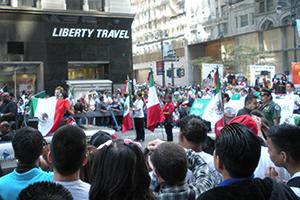Government & Politics
A Tale of Three Cities: Immigrant Exclusion and Belonging

As family separations at the border dominate news coverage, many Americans are waking up to the realities of the US immigration system. Not just the romanticized past of ships crossing the Atlantic for Lady Liberty, but the day-to-day challenges facing immigrants now. Even when migrants find living arrangements, that's just the beginning of the assimilation process.
While any number of people hold opinions about immigration, American University assistant professor Ernesto Castañeda can speak with authority on the subject. Castañeda is a faculty member of the Sociology Department in AU's College of Arts and Sciences. His new book, A Place to Call Home: Immigrant Exclusion and Urban Belonging in New York, Paris, and Barcelona, was 10 years in the making. He conducted hundreds of surveys and lengthy interviews, while immersing himself in the local culture of all three cities. In restaurants, bars, and other gathering places, he talked with migrants and their descendants, as well as local natives wary of immigration.
"There is this common belief that immigrants are a problem, they don't want to integrate, or that they pose a threat to the nation. And I didn't want to discount that so many people have those ideas," says Castañeda in an interview. "But I wanted to see how this translates for actual immigrants. How do immigrants integrate? And are they changing societies in the ways described in the media?"
A Place to Call Home offers a more nuanced explanation of how immigrants live. "The research was very labor intensive, but I think it paints a more complex, fuller picture than we often hear."
Barcelona
In Barcelona, New York, and Paris, immigrants expressed varied experiences of adapting to urban life. Generally speaking, Castañeda found that Barcelona does the best job integrating immigrants, Paris is the least immigrant friendly, and New York City is a mixed bag.
How does Barcelona make immigrants feel welcome? First, Spain's federal immigration policies are quite open. In need of labor as Spain's economy grew, Latin American migrants were sought through solid guest worker programs and good working conditions. Barcelona has policies that favor multiculturalism, with numerous nonprofits that support particular immigrant groups.
"They are able to create this social capital, and through organizations, immigrants know that they're not alone," he explains.
With more leisure time in Barcelona, immigrants of different ethnic backgrounds can socialize with one another. "There are friendships, with people sharing meals and beers, and playing soccer together. So there's real urban interaction, in a way that is not just business or transactional - which is what you have more of in New York," Castañeda notes.
Paris
In Paris, people are discouraged from carrying dual identities and ties to their home countries. Immigrants are expected to abandon their native languages and learn French almost immediately. Muslims in the city are forced to keep their religion out of public view. Migrants are asked to conform quickly and become French, and they do. For the most part they become like their neighbors and people of their same social class. Yet they - somewhat paradoxically - feel less French.
"There's isolation, with people in Paris just living in their own apartments, going to buy bread before retreating back to their homes," he says. "There is this strong expectation of assimilation, that you become like a French upper middle class person from the get-go. And for a lot of immigrants from Algeria or Morocco, that's impossible."
New York
Recent Census numbers show that about 37 percent of New York City residents are foreign born. To some extent - with Ellis Island and other landmarks - the city cherishes its immigrant history. As with Barcelona, people maintain connections to their heritage with events such as the Dominican Day Parade and Cinco de Mayo festivities in Spanish Harlem.
"It's very welcoming and accepting in that way. Even immigrants who don't participate in these celebrations appreciate it, and it's very much tied to the identity of New York," he says.
Yet New York immigrants' struggles emanate from the same issues that beset much of US immigration. There's substantial uncertainty, and as Castañeda notes, it's almost impossible to get citizenship papers nowadays. "No matter what you do, or how many taxes you pay, it's very tough. That's really keeping them from fully becoming part of the city," he says.
Many New York immigrants hold multiple, low-wage jobs with limited economic mobility. "They work so many hours, because they make so little money. So, they don't have time to study English, and they don't have time to hang out with people from other ethnicities," he explains.
Dreams and Aspirations
Castañeda spent hours talking to locals who harbor anti-immigrant sentiments, and he tried to understand their concerns. He says fear of open borders can't be separated from globalization and economic inequality, but he believes politicians are primarily responsible for spreading xenophobia and mistrust. Donald Trump rode "build that wall" all the way to the White House, and European nationalist parties are ascendant in many countries.
Yet in all three cities, Castañeda drew positive conclusions about immigrants' hopes, dreams, and contributions to society. "I found that immigrants are just looking for, as the book is called, 'a place to call home.' They just want to raise a family, have a job, and get an education," he says. "Their goals and values are often the same as those of locals and natives."
Ultimately, he says, it's about becoming a true New Yorker, Parisian, or Barcelonan. "They may be permanent residents - or they may not be - but they want to belong," he asserts. "So the streets are their streets."